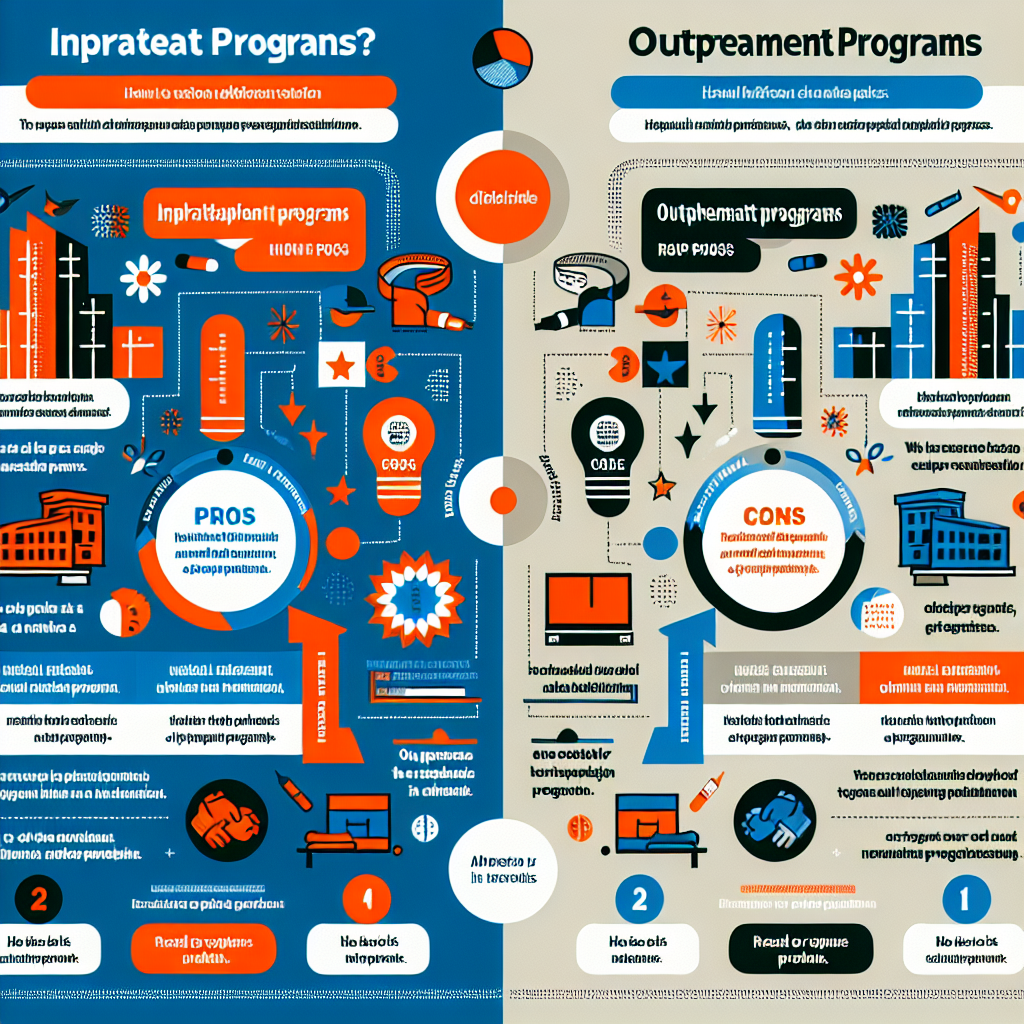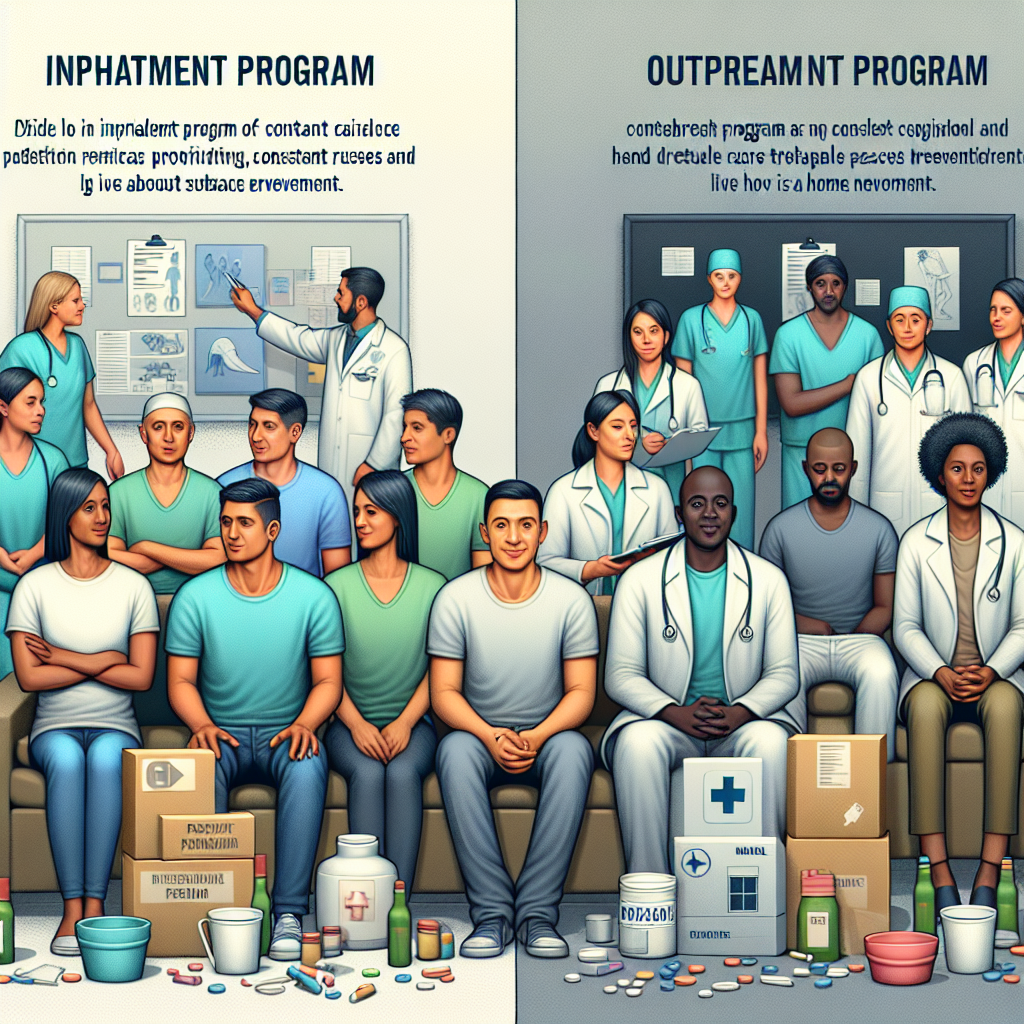-
Table of Contents

“Inpatient vs. Outpatient: Intensive Immersion vs. Flexible Support in Relapse Prevention.”
Introduction
Inpatient and outpatient programs adopt distinct strategies for relapse prevention, tailored to their unique treatment environments and patient needs. Inpatient programs, characterized by their immersive, residential nature, offer a highly structured and controlled setting where patients receive intensive, round-the-clock care. This environment allows for comprehensive monitoring, immediate intervention, and a focus on building foundational skills for long-term sobriety. Conversely, outpatient programs provide treatment while patients continue to live at home, integrating therapy into their daily lives. This approach emphasizes the development of coping mechanisms and relapse prevention strategies that can be directly applied in real-world settings, fostering a gradual and sustainable transition to independent recovery. Both modalities aim to equip individuals with the tools necessary to maintain sobriety, but they do so through different levels of intensity, support, and practical application.
Key Differences in Relapse Prevention Strategies Between Inpatient and Outpatient Programs
Relapse prevention is a critical component of addiction recovery, and both inpatient and outpatient programs employ distinct strategies to address this challenge. Understanding these differences can help individuals and their families make informed decisions about the most suitable treatment approach. Inpatient programs, often referred to as residential treatment, provide a structured environment where individuals live at the facility for a specified period. This immersive setting allows for intensive therapy and constant supervision, which can be particularly beneficial for those with severe addictions or co-occurring mental health disorders. In contrast, outpatient programs offer more flexibility, allowing individuals to live at home and attend treatment sessions at scheduled times. This approach is often suitable for those with milder addictions or those who have already completed an inpatient program and are transitioning back to daily life.
One of the key differences in relapse prevention strategies between inpatient and outpatient programs lies in the level of supervision and support. Inpatient programs provide 24/7 supervision, which can be crucial in the early stages of recovery when the risk of relapse is highest. The constant presence of medical and therapeutic staff ensures that any signs of relapse can be addressed immediately. This continuous support helps individuals develop coping mechanisms and build a strong foundation for long-term sobriety. On the other hand, outpatient programs rely on the individual’s ability to manage their environment and triggers outside of treatment hours. While this can be challenging, it also empowers individuals to apply the skills they learn in real-world settings, fostering a sense of independence and self-efficacy.
Another significant difference is the intensity and frequency of therapy sessions. Inpatient programs typically offer a comprehensive schedule of individual and group therapy sessions, educational workshops, and recreational activities designed to promote holistic healing. This intensive approach allows individuals to delve deeply into the underlying causes of their addiction and develop robust relapse prevention strategies. Conversely, outpatient programs usually involve fewer hours of therapy per week, which can be advantageous for those who need to balance treatment with work, school, or family responsibilities. Despite the reduced intensity, outpatient programs still emphasize the importance of regular therapy and support groups to maintain progress and prevent relapse.
The role of peer support also varies between inpatient and outpatient programs. In an inpatient setting, individuals have the opportunity to form close bonds with others who are going through similar experiences. This sense of community can be incredibly supportive and motivating, as individuals share their struggles and successes in a safe and understanding environment. In outpatient programs, peer support often comes from external support groups such as Alcoholics Anonymous (AA) or Narcotics Anonymous (NA). These groups provide a valuable network of support and accountability, helping individuals stay connected to their recovery community even after formal treatment has ended.
Finally, the transition back to everyday life is handled differently in inpatient and outpatient programs. Inpatient programs often include a structured aftercare plan to help individuals reintegrate into society while maintaining their sobriety. This may involve step-down programs, such as intensive outpatient programs (IOPs) or sober living homes, which provide a gradual transition with continued support. Outpatient programs, by their nature, already incorporate elements of daily life into the treatment process, which can make the transition smoother. However, they also require individuals to be proactive in seeking additional support and resources as needed.
In conclusion, while both inpatient and outpatient programs aim to prevent relapse and support long-term recovery, they do so through different approaches tailored to the needs and circumstances of the individual. By understanding these key differences, individuals can choose the path that best aligns with their recovery goals and lifestyle, ultimately paving the way for a successful and sustainable journey to sobriety.
Comparative Analysis of Relapse Prevention Techniques in Inpatient vs. Outpatient Treatment Programs
In the realm of addiction recovery, relapse prevention is a critical component that can significantly influence long-term success. Both inpatient and outpatient treatment programs offer unique approaches to relapse prevention, each tailored to meet the specific needs of individuals at different stages of their recovery journey. Understanding these differences can provide valuable insights into how each program can be most effectively utilized.
Inpatient programs, often referred to as residential treatment, provide a highly structured environment where individuals live at the treatment facility for a designated period. This immersive setting allows for an intensive focus on recovery, free from the distractions and triggers of everyday life. One of the primary advantages of inpatient programs is the constant access to professional support. This 24/7 availability of medical and psychological care ensures that individuals can receive immediate assistance during moments of vulnerability, which is crucial for preventing relapse.
Moreover, inpatient programs often incorporate a variety of therapeutic modalities, including individual counseling, group therapy, and holistic practices such as meditation and yoga. These diverse approaches aim to address the underlying causes of addiction, equipping individuals with the tools and strategies needed to manage cravings and cope with stress. The sense of community fostered in inpatient settings also plays a significant role in relapse prevention. Sharing experiences and building connections with others who are on a similar path can provide a powerful source of motivation and support.
On the other hand, outpatient programs offer a more flexible approach to treatment, allowing individuals to continue with their daily responsibilities while attending therapy sessions. This flexibility can be particularly beneficial for those who have work, school, or family commitments that cannot be put on hold. Outpatient programs typically involve regular meetings with counselors and participation in group therapy sessions, which can be scheduled around the individual’s existing commitments.
One of the key aspects of relapse prevention in outpatient programs is the emphasis on developing strong coping mechanisms and support networks within the individual’s own environment. Since participants are not removed from their daily lives, they have the opportunity to apply the skills they learn in real-time, navigating triggers and stressors as they arise. This real-world application can be incredibly effective in building resilience and fostering long-term sobriety.
Additionally, outpatient programs often encourage involvement in community-based support groups such as Alcoholics Anonymous (AA) or Narcotics Anonymous (NA). These groups provide ongoing peer support and accountability, which are essential components of relapse prevention. The ability to connect with others who understand the challenges of recovery can help individuals stay committed to their sobriety goals.
While both inpatient and outpatient programs have their distinct advantages, the choice between the two often depends on the individual’s specific needs and circumstances. Inpatient programs may be more suitable for those with severe addictions or co-occurring mental health disorders, as the intensive support and structured environment can provide a solid foundation for recovery. Conversely, outpatient programs may be ideal for those who have already completed an inpatient program or for those with milder addictions who require a more adaptable treatment plan.
Ultimately, the goal of both inpatient and outpatient programs is to empower individuals with the knowledge, skills, and support needed to maintain long-term sobriety. By understanding the different approaches to relapse prevention, individuals can make informed decisions about their treatment options and take proactive steps towards a healthier, more fulfilling life.
Q&A
1. **Question:** How do inpatient programs approach relapse prevention differently from outpatient programs in terms of environment?
**Answer:** Inpatient programs provide a controlled environment with 24/7 supervision, reducing exposure to triggers and stressors, while outpatient programs allow individuals to remain in their home environment, requiring them to manage triggers and stressors in real-time with periodic support.
2. **Question:** How do the therapeutic interventions for relapse prevention differ between inpatient and outpatient programs?
**Answer:** Inpatient programs often offer intensive, daily therapeutic interventions such as individual therapy, group therapy, and holistic treatments, whereas outpatient programs typically provide less frequent therapy sessions, focusing on integrating coping strategies into daily life and maintaining regular check-ins.
Conclusion
Inpatient programs approach relapse prevention by providing a structured, immersive environment where patients receive constant supervision, intensive therapy, and support, which helps them develop coping strategies and address underlying issues without external distractions. Outpatient programs, on the other hand, focus on integrating relapse prevention into the patient’s daily life, offering flexibility and allowing individuals to apply learned skills in real-world settings while maintaining their regular responsibilities. This approach emphasizes ongoing support through regular therapy sessions and support groups, helping patients navigate triggers and stressors in their natural environment.



